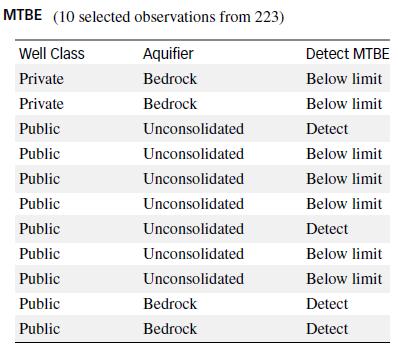Refer to the Environmental Science & Technology (Jan. 2005) study of methyl tert-butyl ether (MTBE) contamination in
Question:
Refer to the Environmental Science & Technology (Jan. 2005) study of methyl tert-butyl ether (MTBE) contamination in New Hampshire wells, Exercise 7.66. How many public and how many private wells must be sampled in order to estimate the difference between the proportions of wells with a detectable level of MTBE to within .06 with 95% confidence?
Data from Exercise 7.66
Refer to the Environmental Science & Technology (Jan. 2005) study of methyl tert-butyl ether (MTBE) contamination in New Hampshire wells, Exercise 2.12. Data collected for a sample of 223 wells are saved in the MTBE file. Recall that each well was classified according to well class (public or private) and detectable level of MTBE (below limit or detect). The accompanying SPSS printout gives the number of wells in the sample with a detectable level of MTBE for both the 120 public wells and the 103 private wells.

Data from Exercise 2.12
In New Hampshire, about half the counties mandate the use of reformulated gasoline. This has led to an increase in the contamination of groundwater with methyl tert-butyl ether (MTBE). Environmental Science & Technology (Jan. 2005) reported on the factors related to MTBE contamination in public and private New Hampshire wells. Data were collected for a sample of 223 wells. These data are saved in the MTBE file. Three of the variables are qualitative in nature: well class (public or private), aquifer (bedrock or unconsolidated), and detectable level of MTBE (below limit or detect). (Note: A detectable level of MTBE occurs if the MTBE value exceeds .2 micrograms per liter.) The data for 10 selected wells are shown in the accompanying table. Use graphical methods to describe each of the three qualitative variables for all 223 wells.

Step by Step Answer:

Statistics For Engineering And The Sciences
ISBN: 9781498728850
6th Edition
Authors: William M. Mendenhall, Terry L. Sincich





